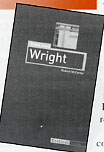 |
Home | Search | Browse | About IPO | Staff | Links |
 |
Home | Search | Browse | About IPO | Staff | Links |

Book Review Wright between the lines Frank Lloyd Wright By Robert McCarter
Robert McCarter's focus in this book is on "the critical events and the defining works of architecture—and the places, occasions, relationships and ideas that shaped them—in the life of the American architect Frank Lloyd Wright." Respecting the page limits imposed on all authors in the publisher's "Critical Lives" series, McCarter touches briefly on the standard fare of Wright biographies. We read first of the tensions between Wright's father and mother; the place of Froebel blocks in his education; his formative years around 1890 with Chicago architect Louis Sullivan; the influence of transcendentalist writers on his philosophy; and his experiences before and during the years in his Oak Park studio. Then comes a good summary of the next stages in Wright's life: After abandoning his wife and six children late in 1909, he traveled to Europe with his lover, Mamah Borthwick, the wife of a client, and returned to Wisconsin the next year to build a studio and home, called Taliesin, near Spring Green. There in 1914, Ms. Borthwick, her two children, and four workers were murdered and the residential portion of Taliesin was burned to the ground! Shattered physically, spiritually, and emotionally, Wright, always the architect, rebuilt himself by practicing his craft. After completing Midway Gardens,a short-lived masterpiece in Chicago, he designed the Imperial Hotel in Tokyo, and spent several years building concrete block houses in California. In the next dozen years his career in architecture languished. He divorced his second wife and married his third, a woman thirty years his junior. His livelihood in these years came from writing and speaking engagements, as well as from fees paid by apprentices who joined the Taliesin Fellowship he and his wife created in 1932. He was then sixty-five years old and lived until 1959 as the co-leader of the Fellowship. This book lacks the insights into Wright's personal life that characterized Ada Louis Huxtable's recent biography (Lipper/Viking, 2004). However, as a practicing architect, McCarter pays more attention to the most salient features of Wright's architectural work and his writings throughout his career. It is therefore an excellent complement to Huxtable's treatment of a man who cannot be captured between the covers of a single book. This is McCarter's seventh book on Frank Lloyd Wright, and he knows him well. It is surprising, therefore, to read that Wright was "primarily responsible" for the design of the Charnley House in Chicago; that he was a member of the Chicago Architectural Club (they sponsored his exhibitions, but he never joined); and that the Playroom in Wright's Oak Park home was on the first floor. Also, in my judgment, McCarter relies too uncritically on Wright's An Autobiography. Near the end of this autobiographical romance Wright offers this acknowledgment: "As I have been writing away, myself autobiographical, I see why all autobiography is written between the lines. It must be so." And it must be so read today. In some respects this book is a compact version of McCarter's copiously illustrated Frank Lloyd Wright (1993). Both conclude with negative appraisals of Wright's last major works, particularly the Grady Gammage Auditorium, the Marin County Center, and the Greek Annunciation Church. The reason for the decline? The "increasingly ritualistic" and "cult-like atmosphere" in the Fellowship made criticism of his work as it progressed impossible. The Fellowship was a loosely knit, insular organization, and it remains so today, but whether it was "cult-like" is disputable. And if lack of criticism of Wright's work by his apprentices diminished its quality—a debatable assertion—their assistance unquestionably multiplied their master's productivity. Frank Lloyd Wright is a well-researched book. Curious persons wanting a brief and engaging introduction to Wright will find it here. More than one-fourth of the sources cited, including Wright's 1932 autobiography, are found in the five volumes of Wright's Collected Writings, edited by Bruce Brooks Pfeiffer, making it possible for readers to follow through on them quite handily. Those choosing to do so will find much fascinating writing in those five volumes. Myron A. Marty, a professor of history emeritus and dean of arts and sciences emeritus at Drake University, lives in Monticello. His current research focuses on the working communities of Frank Lloyd Wright. ILLINOIS HERITAGE 36 |Home|
|Search|
|Back to Periodicals Available|
|Table of Contents|
|Back to Illinois Heritage 2006|
|